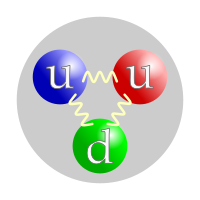
Photo from wikipedia
We have searched for proton decay via $p \rightarrow e^{+} \pi^{0}$ and $p \rightarrow \mu^{+} \pi^{0}$ using Super-Kamiokande data from April 1996 to March 2015, 0.306 megaton$\cdot$years exposure in total.… Click to show full abstract
We have searched for proton decay via $p \rightarrow e^{+} \pi^{0}$ and $p \rightarrow \mu^{+} \pi^{0}$ using Super-Kamiokande data from April 1996 to March 2015, 0.306 megaton$\cdot$years exposure in total. The atmospheric neutrino background rate in Super-Kamiokande IV is reduced to almost half that of phase I-III by tagging neutrons associated with neutrino interactions. The reach of the proton lifetime is further enhanced by introducing new signal criteria that select the decay of a proton in a hydrogen atom. No candidates were seen in the $p \rightarrow e^{+} \pi^{0}$ search. Two candidates that passed all of the selection criteria for $p \rightarrow \mu^{+} \pi^{0}$ have been observed, but these are consistent with the expected number of background events of 0.87. Lower limits on the proton lifetime are set at $\tau/B(p \rightarrow e^{+} \pi^{0}) > 1.6 \times 10^{34}$ years and $\tau/B(p \rightarrow \mu^{+} \pi^{0}) > 7.7 \times 10^{33}$ years at 90% confidence level.
Journal Title: Physical Review D
Year Published: 2017
Link to full text (if available)
Share on Social Media: Sign Up to like & get
recommendations!